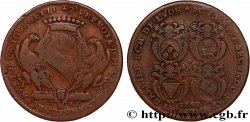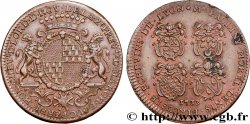fjt_078803 - LYONNAIS - CONSULATE OF LYON Jeton Br 27, Éléonore de Baglion 1638
Not available.
Item sold on our e-shop
Price : 155.00 €
Item sold on our e-shop
Price : 155.00 €
Type : Jeton Br 27, Éléonore de Baglion
Date: 1638
Metal : bronze
Diameter : 27 mm
Orientation dies : 6 h.
Weight : 6,61 g.
Rarity : R2
Coments on the condition:
Frappe légèrement décentrée avec une petite faiblesse de frappe sur une partie des légendes. De petits chocs sur les listels et la tranche. Sinon, un très bel exemplaire avec une patine marron et noire
Catalogue references :
Obverse
Obverse legend : * DE* LA* PREVOSTE* DES* MARCH* DE* MR* LE* BAR* DE* IONS* 1638.
Obverse description : Écu entouré du collier de l’ordre de Saint-Michel et aux armes d’Éléonor de Baglion, baron de Jons, timbré d’un casque taré de face, orné de lambrequins et ayant pour cimier un lion issant tenant un tronc écoté.
Obverse translation : (De la prévôté des marchands de Monsieur le baron de Jons).
Reverse
Reverse legend : * DE* LA* CONSTITV* DE* C* M* LIVRE* DE* RENTE* SVR* LES* GAB.
Reverse description : Écu écartelé de quatre écussons aux armes des échevins Jean de Pomey, Jacques Cardon, Nicolas Serre et Barthélémy Ferrus, le tout surmonté d’un casque taré au tiers orné de lambrequins.
Reverse translation : (De la constitution de cent mille livres de rente sur les gabelles).
Commentary
Ces jetons ne furent pas payés par la ville mais offerts par les traitants des rentes sur les gabelles du sel de la généralité, à la suite d’une opération dont ces derniers avaient profité. Pour la première fois sur la série sont réunies les armes du Prévôt et des quatre échevins, disposition qui deviendra classique jusqu’en 1749.








 Report a mistake
Report a mistake Print the page
Print the page Share my selection
Share my selection Ask a question
Ask a question Consign / sell
Consign / sell
 Full data
Full data



